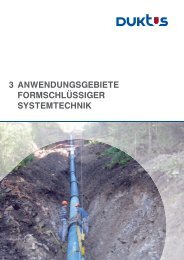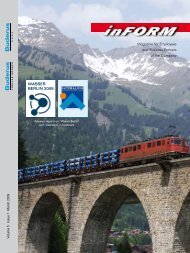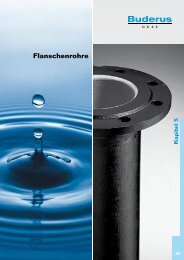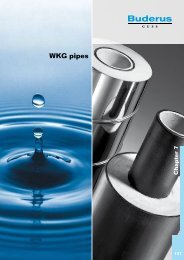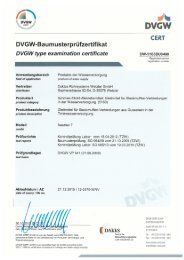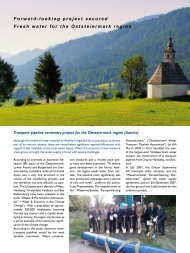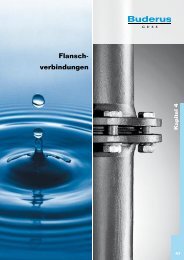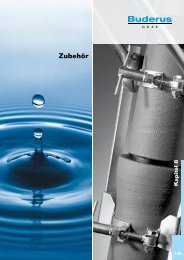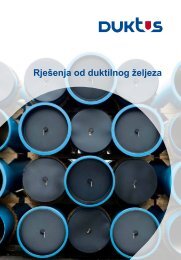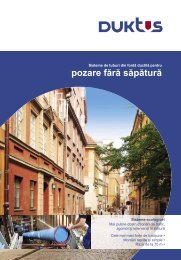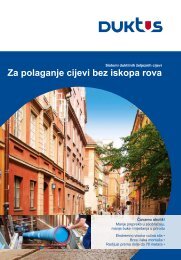InFORM 02.2008 (PDF-File) - Duktus
InFORM 02.2008 (PDF-File) - Duktus
InFORM 02.2008 (PDF-File) - Duktus
Create successful ePaper yourself
Turn your PDF publications into a flip-book with our unique Google optimized e-Paper software.
So that the landscape is spoiled as little as<br />
possible, the whole of the pressure pipe<br />
has been constructed as a DN 600 underground<br />
pipeline (of wall thickness classes<br />
K9 and K10). The turbine building is being<br />
partly buried in earth bankings.<br />
Nor have the fish been forgotten: so that<br />
there is no risk to their spawning grounds,<br />
a so-called fish ladder has been incorporated<br />
in the water intake structure. What<br />
is more, small hydroelectric stations have<br />
a beneficial effect on fish stocks anyway,<br />
because the eddies from the turbines introduce<br />
oxygen into the water.<br />
The special feature of this project is the<br />
many inspection and connection „manholes“<br />
distributed along the length of the<br />
. kilometre long path followed by the<br />
pipe carrying the feed water. Four inspection<br />
openings (or „manholes“, in the<br />
form of DN 600/600 all-flanged tees) have<br />
been installed to provide access facilities<br />
to the pipe every 600 meters for inspection<br />
work. However, the pipe carrying the<br />
feed water supplies water not only to the<br />
turbine but also to two branch pipes running<br />
to hydrants, which are to be used for<br />
fighting forest fires. There are also four<br />
nearby farms whose sprinkler systems<br />
are being connected to the new pressure<br />
pipe.<br />
For the most part, the route followed by<br />
the pipe is along forest roads and through<br />
areas of forest but there are also two high<br />
points where it crosses the Winnebach.<br />
To avoid any air inclusions in the pipe, it is<br />
necessary for an automatic air supply and<br />
air venting unit to be installed.<br />
Because of the many special structures,<br />
the Winnebach hydroelectric generator<br />
station project involves more fittings than<br />
any other turbine project for the past ten<br />
years – about 110 fittings are being installed.<br />
Another novel feature is the system for<br />
locating leaks by means of fibre optics. To<br />
enable possible leaks to be located as accurately<br />
as possible, a fibre optic cable has<br />
been laid below the bottom of the pipe.<br />
This technique has been developed by<br />
the University of Hydraulic Engineering<br />
at Innsbruck.<br />
(We will be publishing a report on this subject<br />
in the next issue of inFORM.)<br />
Mountains, castles and sundials<br />
The Pustertal in South Tyrol:<br />
a paradise for nature-lovers and<br />
culture-seekers<br />
The Pustertal is a valley whose height<br />
ranges from 700 to approximately<br />
1,600 metres. It is situated mainly in<br />
South Tyrol and it runs between Brixen<br />
and Lienz. It branches off eastwards<br />
from the Eisacktal at a point to the north<br />
of Brixen and the rivers Rienz and Drau<br />
flow through it. In the High Pustertal,<br />
there are the characteristic peaks of<br />
the Sexten and Lienz Dolomites. This<br />
is also the place where the celebrated<br />
Drei Zinnen tower into the sky. Deodat<br />
de Dolomieu was the first man to investigate<br />
the calcareous rocks in the region,<br />
and it is from him that these peaks<br />
take their name. The Dolomites have a<br />
close connection with the history of alpine<br />
mountaineering. A name that will<br />
be remembered in this connection is the<br />
film director and actor Luis Trenker, who<br />
came from the Tyrol and whose films often<br />
„starred“ mountain landscapes.<br />
The Pustertal has some 73,000 inhabitants<br />
living on a good 2,000 square kilometres<br />
of land. The best known towns<br />
are Bruneck, Wengen and Toblach.<br />
From the administrative point of view<br />
it consists of the districts of Hochabtei,<br />
Hochpustertal, Kronplatz and Tauferer<br />
Ahrntal.<br />
A wide range of sporting activities are<br />
available: climbing, hiking, mountainbiking,<br />
paragliding, rafting and much<br />
else besides. In winter, the High Pustertal<br />
is an absolute paradise for skiers.<br />
A special attraction is the micro-climate<br />
tunnel at Prettau. This is a disused mine<br />
gallery in which there are micro-climatic<br />
conditions consisting of a temperature<br />
of about 9° Celsius and a relative<br />
humidity of approximately 95%. These<br />
have a beneficial effect particularly on<br />
people suffering from respiratory prob-<br />
lems. In the Pustertal tourists will find<br />
everything they want from luxury hotels<br />
to family-owned boarding houses. The<br />
charm of the valley comes from the association<br />
of the old and the new, of traditional<br />
country life and modern-day living,<br />
of the Tyrolean and the Italian.<br />
Seeing the well-preserved town walls<br />
and town gates and the castle at Bruneck,<br />
the visitor will find himself transported<br />
into the middle ages. Nowhere<br />
else in Europe are there so many properties<br />
dating from the middle ages situated<br />
so closely together as there are<br />
here. With its 400 or so castles and citadels,<br />
South Tyrol generally is the region<br />
which can boast the largest number of<br />
medieval edifices. There are many romances<br />
from the age of chivalry that<br />
tell the story of those times. Rodeneck<br />
Castle is one of the largest castles in<br />
South Tyrol and is the home of a renowned<br />
cycle of frescoes dating from<br />
the 13th century showing scenes from<br />
Hartmann von Aue‘s Middle High German<br />
epic „Iwein“. The „Gustav Mahler<br />
Music Weeks“ would also seem to<br />
be a byword among lovers of classical<br />
music. Today, handicrafts are still a living<br />
presence in the Pustertal in the form<br />
of its wood-carving, its lace-making, its<br />
weaving and its making of Patschen or<br />
felt shoes. Typical culinary products are<br />
cheese and home-cured bacon.<br />
A special event is the Stegener Market<br />
which is held in autumn every year and is<br />
the biggest food and handicraft market<br />
in the whole of Tyrol. There are booths<br />
there selling mulled wine and the special<br />
little sausages and stalls where you<br />
can buy schnapps and cheeses and all<br />
sorts of handicraft products.<br />
That the people in the Pustertal seem<br />
to have a rather sunny disposition is<br />
shown by one of the other special features<br />
of the region: the many sundials.<br />
What is it that people say? Only count<br />
the happy hours!<br />
TRM – Cast iron pipe technology<br />
9



